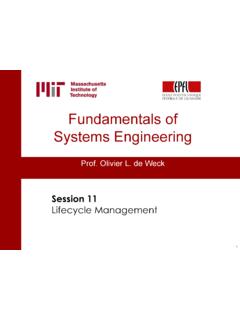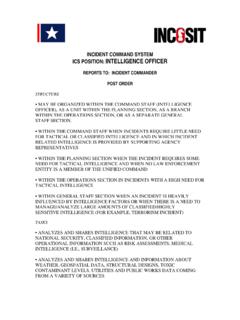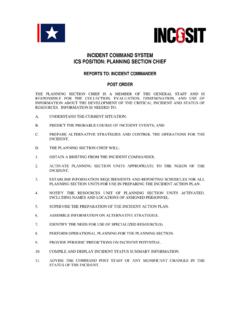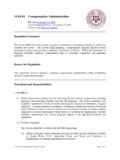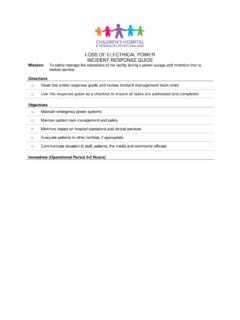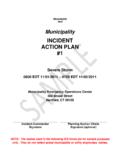Transcription of USS Vincennes Incident - MIT OpenCourseWare
1 USS Vincennes IncidentDan CraigDan MoralesMike OliverOverview Introduction and Historical Context Incident Description Aegis system Description Human Factors Analysis Recommendations ReferencesSynopsis USS Vincennes mistakenly shot down Iran Air Flight 655 Vincennes : Aegis class cruiser with advanced tracking radar IA 655: Airbus A300, but misidentified as an Iranian Air Force F-14 Occurred July 3, 1988, Strait of HormuzHistorical Background Iran and Iraq at war since 1981 US skirmished with both countries since 1987 Protecting Kuwaiti and other foreign oil tankers Iranian gunboats attacking neutral tankers, USN ships, mining international water ways Iraqi attack on USS Stark in May 1987 Exocetanti-ship missiles 37 Americans killed US Intelligence predicted attacks around July 4th, 1988 NOTAM sissued to monitor civilian and military distress channels and respond to US military directionsChronology 10:47 AM While Vincennes engaged with Iranian gunboats, IA655 appears on radar as Unknown Assumed Enemy approaching the ship Identification Friendly or Foe (IFF) shows both COMAIR and MILAIR 10:49 AM Vincennes warns aircraft on military frequency, no response 10:50 AM Warnings repeated, civilian and military channels, no responseSaltus, Richard.
2 A Tragic Error Led to New Insights on Behavior in Crisis Boston Globe28 Feb 1994 Chronology, cont d 10:51 AM Aircraft warned will be shot down at 20 nm unless change course, no response 10:51 AM Vincennes holds fire, confusion about whether descending or climbing 10:53 AM Final warning, no response 10:54 AM Two SM-2 missiles launched, IA655 is 8 nm away at 13,500 feetSaltus, Richard. A Tragic Error Led to New Insights on Behavior in Crisis Boston Globe28 Feb 1994 AEGIS Weapons system Design criteria Cold war blue water battles Doctrine Levels of automation Components ( , 2000) AN/SPY-1 Radar AN/UYK-1 Computer Link-X Human OperatorsCombat Information Center(Gaston, 2003)031125-N-0119G-002 Arabian Gulf (Nov. 25, 2003) --Operations Specialist 1st Class Derrick L. Johnston from Meadville, Pa., (left) tracks interceptions of aircraft and reports them to the Tactical Actions Officer (TAO), Lt. Cmdr. Michael J. Yager from Troy, , (right) in the Combat Direction Center (CDC).
3 CDC is the nerve center of the nuclear powered aircraft carrier, USS Enterprise (CVN 65). This is where information is collected, processed, displayed, evaluated, and disseminated from sources outside and inside the ship. Navy photo by Photographer's Mate Rob Gaston. (RELEASED)(Pendergrass, 2003)030305-N-3235P-522 At sea aboard USS San Jacinto (CG 56) Mar. 5, 2003 --Fire Controlman Joshua L. Tillman along with three other Fire Controlmen, man the ship s launch control watch station in the Combat Information Center (CIC) aboard the guided missile cruiser during a Tomahawk Land Attack Missile (TLAM) training exercise. San Jacinto is deployed in support of Operation Enduring Freedom. Navy photo by Photographer's Mate 1st Class Michael W. Pendergrass. (RELEASED)Low LevelDefensesSensorsAN/SPY-1 AirOther Sensors:Radar/SonarLink-X:Ships/ACAN/UYK -1 SurfaceSub-SurfaceCommandingOfficerLarge DisplayWarfareCommandersOperators(20-40) DisplaysCIC(Hansman and Kaliardos, 2000)Moderate LevelDefensesSensorsAN/SPY-1 AirOther Sensors:Radar/SonarLink-X:Ships/ACAN/UYK -1 SurfaceSub-SurfaceCommandingOfficerLarge DisplayWarfareCommandersOperators(20-40) DisplaysCICHigh LevelDefensesSensorsAN/SPY-1 Other Sensors:Radar/SonarLink-X:Ships/ACAirAN/ UYK-1 SurfaceSub-SurfaceDisplaysCommandingOffi cerLarge DisplayOperators(20-40)WarfareCommanders CICH uman Factors Analysis Disaster was caused by multiple factors.
4 Human error Poor decision making Erroneous expectancies Human/ system interface mishaps system deficiencies Lack of trainingAlthough many analysts have tried in the past 15 years to point to a single factor theory, the general consensus remains that the shoot down of Iran Flight 655 was caused by a multitude of factors. In the interests of time, we have attempted to simplify those factors into two main categories: Human error and Mishaps due to the human/ system interface. By human error, I mean poor decision making and erroneous expectancies and other psychological factors that contributed to an inaccurate portrayal of the actual situation. Many human errors were directly caused by deficiencies in the Vincennes automated system as well as a lack of training that led to faulty interpretation of data and more Decision Making 0633: Capt Rogers orders all ahead flank without orders from superiors 0840: USS Vincennes is 40 miles north of required position 0845: Capt Rogers leaves helicopter behind, which follows gunboats north 0939: Capt Rogers uses ambiguous information as evidence to openfire 0941: USS Vincennes illegally crosses into Iranian watersBefore explaining this slide, I would just like to say that it is very easy for us to review 15 years worth of critiques and analyses and to then judge the decisions made by a military commander in a combat situation.
5 However, the actions and decisions detailedon this slide show an undeniable and unequivocal tendency towards what I call picking a fight. These details were not necessarily direct causes of the shoot down, but the main resultwas to put the USS Vincennes into a very precarious 6:33 local time, acting without any orders from his superiors, Capt Rogers orders all ahead flank and proceeds from about here (point to map) 50 miles northeast (point again) to where theUSS Montgomery had reportedly sighted 13 Iranian speedboats in an attempt to get involved in the action. After some explosions are heard, the command center in Bahrain orders Capt Rogers to stay south, but to send his helicopter north on a reconnaissancemission. At 8:40 however, Capt is startled to see that the Vincennes was almost on top of the Omani peninsula, about 40 miles north of where she was supposed to be. Angry, McKenna orders Rogers back to Abu Musa.
6 Unfortunately, Rogers leaves his helicopter behind, whose pilot, Lt Mark Collier, decides to follow the speedboats as they retreat north towards Iran at 8:45. The helicopter eventually takes some fire, and the Vincennes jumps back into the fray. Heading towards the majority of the speedboats, he is unable to get a clear target. Also, the speedboats are now just slowly milling about in their own territorial waters. Despite clear information to the contrary, Rogers informs command that the gunboats are gathering speed and showing hostile intent and gains approval to fire upon them at 0939. Finally, in another fateful decision, he crosses the 12-mile limit off the coast and enters illegally into Iranian waters, which will prove to have far-reaching implications. At this point, Capt Rogers and the USS Vincennes had just set themselves up for a very bad , for future reference, this (point) is the airport from which Flight 655 departed, and this (point) is the airport to whichthey were headed.
7 As you can see, the USS Vincennes lay directly in the airplane s Expectancies Memories of USS Stark Incident initiated scenario fulfillment occurrence Operators claimed the incoming aircraft was descending and picking up speed Anonymous shouts and warnings contributed to tense atmosphere Capt Rogers paid more attention to emergency signals than computer displays Stress, tension, lack of time, and fog and friction of war all contributed to the problemThe majority of the crew members on board the USS Vincennes thatday had created an erroneous expectancy of what was happening. This was partially caused by fresh memories of the USS Stark, which was severely damaged a year earlier by an Iraqi fighter jet. Many psychologists call this concept scenario fulfillment. Iran Flight 655 took off from the joint civilian/militaryairport at Bandar Abbasat about 10:17. As it was climbing to its cruising altitude, five crew members in the CIC on the Vincennes independently believed that the incoming aircraft was descending and picking up speed.
8 Anonymous shouts and warnings created a very tense atmosphere in the CIC. Capt Rogers and other officers paid more attention to the shouts, warnings, and emergency signals than to the actual displays and print outs of the Aegis system , which, if carefully analyzed, would have easily shown that the incoming aircraft was a commercial airplane and was in fact simply climbing to its cruising altitude. Probably a very significant factor in all of this was the stress, tension, lack of time, and fog and friction of war. Flight 655 was detected by radar at 10:17 and was shot down 7 minutes later at 10:24, when it came within 10 miles of the Vincennes . 7 minutes is a short time to make such a critical decision, especially with all that was goinon at the time in the Deficiencies Aegis not intended for small-craft battles in enclosed area like Persian Gulf Combat Information Center (CIC) provided no actual view of the area CIC was dark, and its few lights flickered every time the Vincennes fired at speedboats Electronic and verbal confusion in CIC IFF device had to be manually reset Papers and books flew off consoles as ship swung around to bringguns to bear on speedboats Radar displays violated Proximity Compatibility Principle (Wickensand Hollands, 2000) Duplicate tracking numbers with no computer alert (Fisher, 2001)And to tell you about what was going on, I would like to talk about the deficiencies of the system itself.
9 And by system , I don t simply mean the Aegis computer. I mean the complete interaction between man and machine. A little bit of the Human Centered system Approach would have gone a long way in this case. First, the Aegis cruisers were not designed for small-craft battles in the enclosed areas like the Persian Gulf. Instead, they were designed for all-out battles in the open sea with the Soviet Union. So that was a problem, especially when trying to track and fire upon those annoying little speedboats. The CIC also provided no actual view, no actual video, of the area and the situation and displays are nice, but it is also helpful to bring some reality to the area where the decisions are made. The CIC was also very dark, and the few lights it did have flickered every time the Vincennes fired at the speedboats. This was of special concern to Petty Officer Andrew Anderson, who first picked up Flight 655on radar and thought it might be a commercial aircraft.
10 As he was searching in the navy s listing of commercial flights, he apparently missed Flight 655 because it was so dark. There was a great deal of electronic and verbal confusion in the CIC as well. Capt Rogers and his key commanders where linked on a certain communications circuit. However, over half of the crew on the Vincennes had figured out a way to tap into the circuit to listen to everything that was going on. This drained the power on the circuit and forced some Lt to switch the frequency every now andthen and call out switch! as loudly as he could while doing it. One problem that could have prevented the entire disaster also had to with Petty Officer Anderson. The first time he had beamed out his IFF query to the departing airplane, he had received back the signature of a commercial airplane. However, after someone had shouted out that it could be an F-14, Anderson used his IFF again, but this time received back thesignature of a military airplane.
